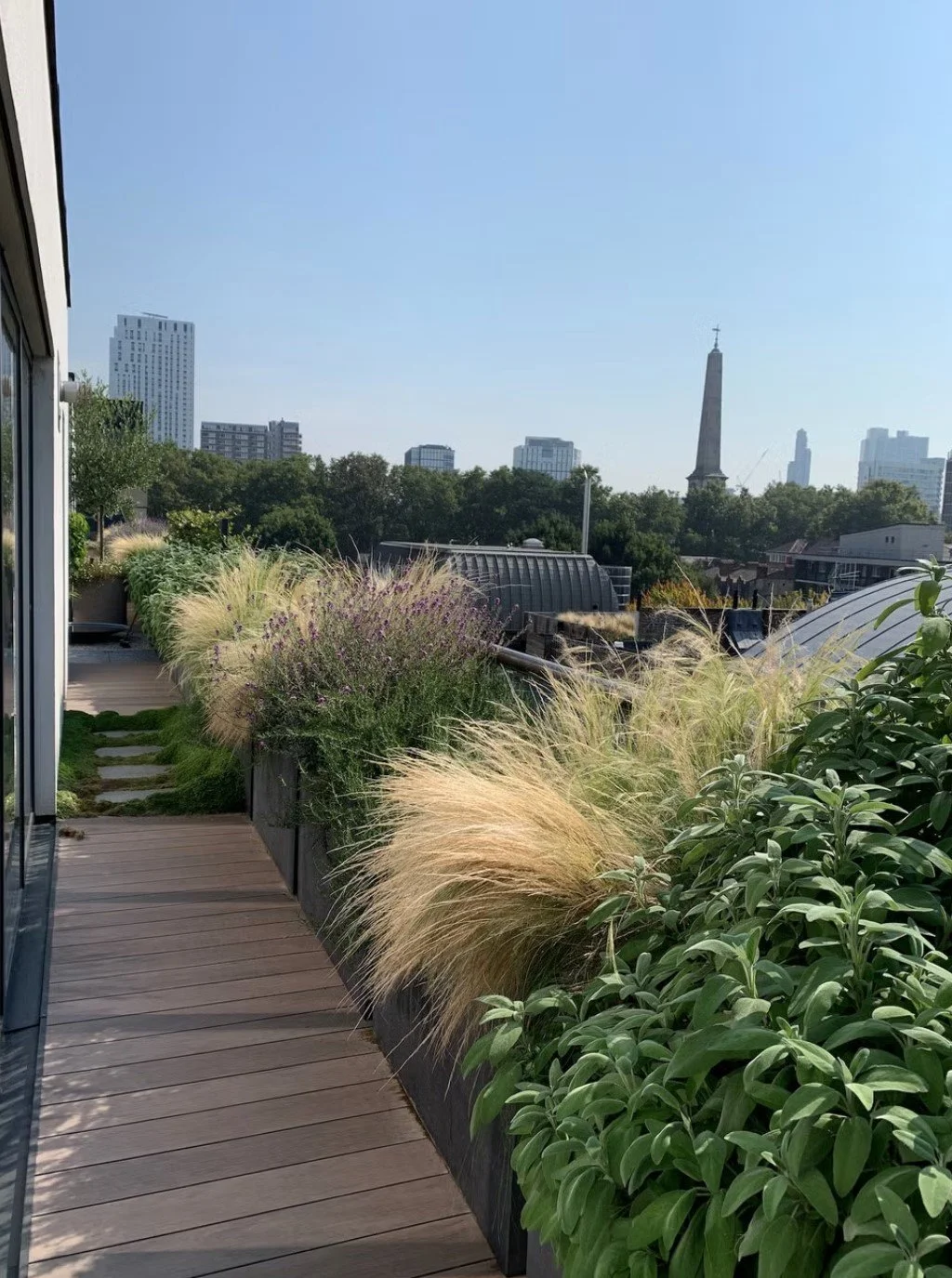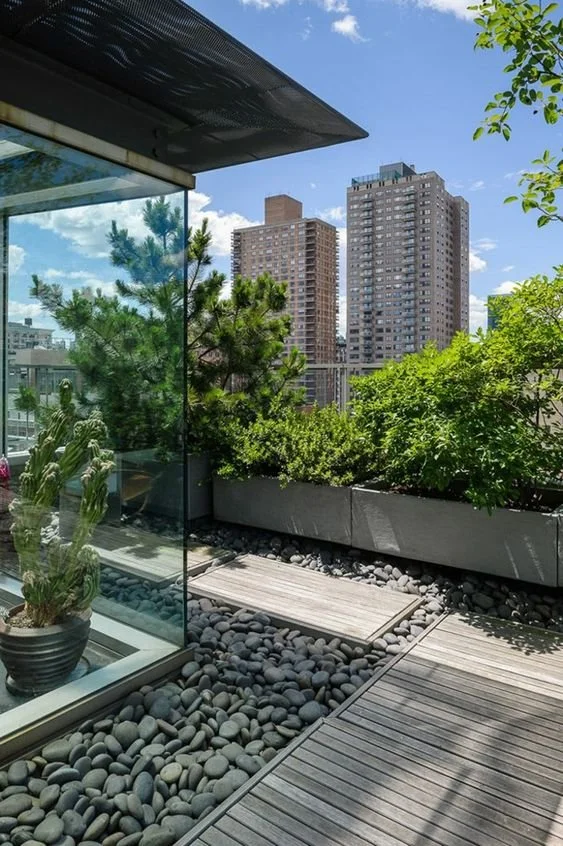Planning and Concept Development for Balcony Gardens in Canberra
A successful balcony garden starts with thoughtful planning. Without a clear concept and understanding of the space, you may end up with a design that doesn’t fulfil your needs or your garden’s potential. In Canberra’s climate, where extreme weather can challenge even the most resilient plants, the planning phase is crucial.
In this post, we’ll explore the key steps involved in planning your balcony garden. From understanding the space to balancing aesthetics with function, these steps will help you create a space that thrives in Canberra’s climate.
A lovely blend of grasses & perennial herbs, this very seasonal balcony garden offers a naturalistic outlook over an otherwise quite uniform planted skyline. Designed by Bowles & Wyer.
Key Balcony Garden Planning Concepts
1. Design Considerations
Understanding the Purpose: The first step in planning your balcony garden is understanding its purpose. Ask yourself: Is the garden meant to be a retreat where you can spend time, or is it intended to create a natural, relaxing view from inside your apartment?
Creating the Vibe: Once you understand how you’ll use the space, the next step is to define the vibe. The aspect—how much sun the balcony receives at different times of the day and year—plays a major role in shaping the design.
Moodboard: To capture the mood and feeling of the garden, create a moodboard that reflects the types of plants, colors, and textures you want to incorporate. But be wary while making moodboards, there are heaps of beautiful images online, but many, if not most of them, are not applicable in our specific local context.
2. Understanding the Space
Assessing the Area: Begin by evaluating the available space. Measure the physical dimensions and identify areas that receive the most sun or shade. Take note of the balcony's orientation, particularly where north is directly facing and where west to southwest lies. The west to southwest orientation is crucial as it receives the most intense afternoon sun.
Weight Limits and Structural Considerations: Check the load-bearing capacity of your balcony and ensure that any containers, plants, and materials you use stay within safe weight limits. Additionally, consider structural factors like drainage and whether the balcony can handle water runoff without causing issues for neighbors or rooms below.
Practical Tips:
Measure the space carefully and map out where larger plants or seating areas will go.
Consult building guidelines to understand weight limits and restrictions. You should be able to get weight load limits (expressed as live and dead loads as a weight in kilograms per square meter) from your building plans or structural reports, usually held by the building manager.
Plant the toughest, hardiest plants to the southwest. Plants with large, soft leaves will be more susceptible to burning than plants with smaller leaves.
Assessing Body Corporate Permissions
Many apartments or multi-unit complexes have body corporate or strata rules governing what can and cannot be done on balconies. This can affect decisions around installing permanent structures and potentially even plant selections.
Practical Tip: Before starting your balcony garden project, check the building's bylaws and get approval for any significant changes. Ensure you have clear communication with the body corporate about load limits, drainage, and any visual changes to the building's exterior.
3. Balancing Aesthetics with Function
Design and Practicality: Aesthetics are important, but in Canberra’s climate, functionality is key. Your design should reflect both your aesthetic preferences and the practical needs of your plants.
Balancing for Weather: Consider how to protect your plants from extreme heat, wind, and frost. Larger trees and shrubs can be used to provide shade and shelter, while hardscaping elements such as screens and windbreaks can enhance both the garden’s look and its function.
Feeling of permanence: One of the most important factors in adding long-term value to your apartment is creating a garden that feels like a permanent part of the space. A well-integrated garden, where plants and structures are carefully chosen to complement the balcony, gives a sense of permanence and luxury—rather than a temporary setup of pots that will be removed when the tenant leaves.
Practical Tips:
Use a mix of plant heights and densities to create a layered, protective environment.
Incorporate functional hardscaping elements to improve both plant health and design aesthetics.
4. Choosing the Right Materials
The key to a successful balcony garden lies in making it feel like a natural, permanent extension of the apartment. By selecting the right containers and integrating them into the overall layout, you can avoid the common ‘temporary’ look of disconnected pots. The garden should feel rooted in the space, with plants, trellises, and other elements becoming part of the balcony’s structure, creating a sense of stability, permanence, and added value to your home.
Durability and Weight: The materials you choose need to be durable enough to withstand Canberra’s hot summers and frosty winters, while also being lightweight enough to stay within your balcony’s load limits.
Materials That Work Well: Lightweight containers made from fiberglass or steel are great for reducing weight without sacrificing strength. For built elements, choose weather-resistant materials like powder-coated metals, bamboo, australian red hardwoods, or natural stone.
Practical Tips:
Select containers that are lightweight but durable enough to handle weather extremes.
Use sustainable materials that can withstand Canberra’s conditions while reducing environmental impact.
This minimalist balcony garden draws inspiration from the tradition of Zen gardening in Japan. A natural material palette of wood & stone with soft green vegetation to bring the feeling of nature close to home.
Planning your balcony garden requires a clear understanding of its purpose, space, and limitations. By balancing aesthetics with function and selecting the right materials, you’ll set the foundation for a thriving garden that handles Canberra’s climate challenges with ease.
Want to keep reading?
Check out the next post in this series: Intro to Balcony Load Limits: Creating Safe and Thriving Balcony Gardens.
Want expert help?
Check out my Balcony Design and Construction Services page.


